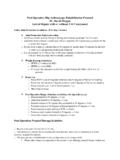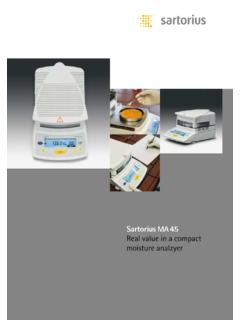Transcription of The ICD-10 Classification of Mental and Behavioural …
1 -1- The ICD-10 Classification of Mental and Behavioural Disorders Clinical descriptions and diagnostic guidelines World Health Organization -2-Preface In the early 1960s, the Mental Health Programme of the World Health Organization (WHO) became actively engaged in a programme aiming to improve the diagnosis and Classification of Mental disorders. At that time, WHO convened a series of meetings to review knowledge, actively involving representatives of different disciplines, various schools of thought in psychiatry, and all parts of the world in the programme. It stimulated and conducted research on criteria for Classification and for reliability of diagnosis, and produced and promulgated procedures for joint rating of videotaped interviews and other useful research methods.
2 Numerous proposals to improve the Classification of Mental disorders resulted from the extensive consultation process, and these were used in drafting the Eighth Revision of the International Classification of Diseases (ICD-8). A glossary defining each category of Mental disorder in ICD-8 was also developed. The programme activities also resulted in the establishment of a network of individuals and centres who continued to work on issues related to the improvement of psychiatric Classification (1, 2). The 1970s saw further growth of interest in improving psychiatric Classification worldwide. Expansion of international contacts, the undertaking of several international collaborative studies, and the availability of new treatments all contributed to this trend. Several national psychiatric bodies encouraged the development of specific criteria for Classification in order to improve diagnostic reliability.
3 In particular, the American Psychiatric Association developed and promulgated its Third Revision of the Diagnostic and Statistical Manual, which incorporated operational criteria into its Classification system. In 1978, WHO entered into a long-term collaborative project with the Alcohol, Drug Abuse and Mental Health Administration (ADAMHA) in the USA, aiming to facilitate further improvements in the Classification and diagnosis of Mental disorders, and alcohol- and drug-related problems (3). A series of workshops brought together scientists from a number of different psychiatric traditions and cultures, reviewed knowledge in specified areas, and developed recommendations for future research. A major international conference on Classification and diagnosis was held in Copenhagen, Denmark, in 1982 to review the recommendations that emerged from these workshops and to outline a research agenda and guidelines for future work (4).
4 Several major research efforts were undertaken to implement the recommendations of the Copenhagen conference. One of them, involving centres in 17 countries, had as its aim the development of the Composite International Diagnostic Interview, an instrument suitable for conducting epidemiological studies of Mental disorders in general population groups in different countries (5). Another major project focused on developing an assessment instrument suitable for use by clinicians (Schedules for Clinical Assessment in Neuropsychiatry) (6). Still another study was initiated to develop an instrument for the assessment of personality disorders in different countries (the International Personality Disorder Examination) (7). In addition, several lexicons have been, or are being, prepared to provide clear definitions of terms (8). A mutually beneficial relationship evolved between these projects and the work on definitions of Mental and Behavioural disorders in the Tenth Revision of the International Classification of Diseases and Related Health Problems -3-( ICD-10 ) (9).
5 Converting diagnostic criteria into diagnostic algorithms incorporated in the assessment instruments was useful in uncovering inconsistencies, ambiguities and overlap and allowing their removal. The work on refining the ICD-10 also helped to shape the assessment instruments. The final result was a clear set of criteria for ICD-10 and assessment instruments which can produce data necessary for the Classification of disorders according to the criteria included in Chapter V(F) of ICD-10 . The Copenhagen conference also recommended that the viewpoints of the different psychiatric traditions be presented in publications describing the origins of the Classification in the ICD-10 . This resulted in several major publications, including a volume that contains a series of presentations highlighting the origins of Classification in contemporary psychiatry (10). The preparation and publication of this work, Clinical descriptions and diagnostic guidelines, are the culmination of the efforts of numerous people who have contributed to it over many years.
6 The work has gone through several major drafts, each prepared after extensive consultation with panels of experts, national and international psychiatric societies, and individual consultants. The draft in use in 1987 was the basis of field trials conducted in some 40 countries, which constituted the largest ever research effort of this type designed to improve psychiatric diagnosis (11, 12). The results of the trials were used in finalizing these guidelines. This work is the first of a series of publications developed from Chapter V(F) of ICD-10 . Other texts will include diagnostic criteria for researchers, a version for use by general health care workers, a multiaxial presentation, and "crosswalks" - allowing cross-reference between corresponding terms in ICD-10 , ICD-9 and ICD-8. Use of this publication is described in the Introduction, and a subsequent section of the book provides notes on some of the frequently discussed difficulties of Classification .
7 The Acknowledgements section is of particular significance since it bears witness to the vast number of individual experts and institutions, all over the world, who actively participated in the production of the Classification and the guidelines. All the major traditions and schools of psychiatry are represented, which gives this work its uniquely international character. The Classification and the guidelines were produced and tested in many languages; it is hoped that the arduous process of ensuring equivalence of translations has resulted in improvements in the clarity, simplicity and logical structure of the texts in English and in other languages. A Classification is a way of seeing the world at a point in time. There is no doubt that scientific progress and experience with the use of these guidelines will ultimately require their revision and updating. I hope that such revisions will be the product of the same cordial and productive worldwide scientific collaboration as that which has produced the current text.
8 Norman sartorius Director, Division of Mental Health World Health Organization References -4- , M. et al. The ICD-9 Classification of Mental disorders: a review of its developments and contents. Acta psychiatrica scandinavica, 59:241-262 (1979). , N. Classification : an international perspective. Psychiatric annals, 6: 22-35 (1976). , A. et al. Diagnosis and Classification of Mental disorders and alcohol- and drug-related problems: a research agenda for the 1980s. Psychological medicine, 13:907-921 (1983). disorders, alcohol- and drug-related problems: international perspectives on their diagnosis and Classification . Amsterdam, Excerpta Medica, 1985 (International Congress Series, No. 669). , L. et al. The composite international diagnostic interview. Archives of general psychiatry, 45: 1069-1077 (1989).
9 , et al. SCAN: schedules for clinical assessment in neuropsychiatry. Archives of general psychiatry, 47: 589-593 (1990). , et al. The WHO/ADAMHA international pilot study of personality disorders: background and purpose. Journal of personality disorders, 5(3): 296-306 (1991). of psychiatric and Mental health terms. Vol. 1. Geneva, World Health Organization, 1989. Statistical Classification of Diseases and Related Health Problems. Tenth Revision. Vol. 1: Tabular list, 1992. Vol. 2: Instruction Manual, 1993. Vol. 3: Index (in press). Geneva, World Health Organization. , N. et al. (ed.) Sources and traditions in Classification in psychiatry. Toronto, Hogrefe and Huber, 1990. , N. et al. (ed.) Psychiatric Classification in an international perspective. British journal of psychiatry, 152 (Suppl. 1) (1988). , N. et al. Progress towards achieving a common language in psychiatry: results from the field trials of the clinical guidelines accompanying the WHO Classification of Mental and Behavioural Disorders in ICD-10 .
10 Archives of general psychiatry, 1993, 50:115-124. -5-Acknowledgements Many individuals and organizations have contributed to the production of the Classification of Mental and Behavioural disorders in ICD-10 and to the development of the texts that accompany it. The field trials of the ICD-10 proposals, for example, involved researchers and clinicians in some 40 countries; it is clearly impossible to present a complete list of all those who participated in this effort. What follows is a mention of individuals and agencies whose contributions were central to the creation of the documents composing the ICD-10 family of classifications and guidelines. The individuals who produced the initial drafts of the Classification and guidelines are included in the list of principal investigators on pages 312-325: their names are marked by an asterisk.
















